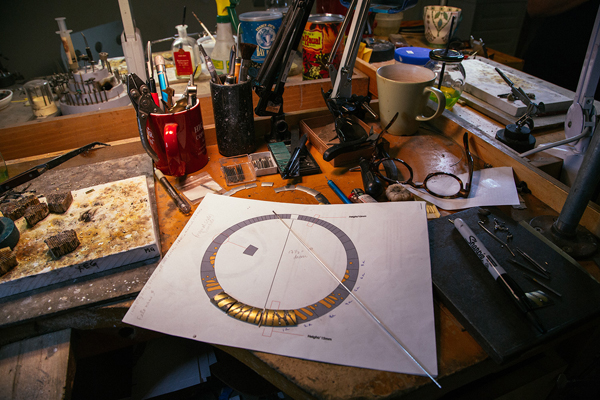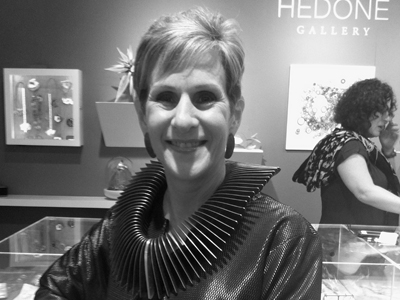
Bonnie Levine: How did you get started as a jeweler, and when did you realize you were hooked?
Rebecca Myers: I had to fulfill a craft requirement when I was a sophomore at Tyler School of Art in Philadelphia. While I was actually making something, the other kids in my class were melting things and setting their clothing on fire. I realized that I was actually pretty good at it. It initially was the path of least resistance. I then got hooked on figuring out how to design things that were desirable and wearable. Once I started down the path of putting an actual line together, the process got really exciting for me. I sold the small line I made my senior year to a gallery in New Hope, Pennsylvania. That $500 may as well have been $5,000. I was elated!
The hardest thing about building a successful jewelry line wasn’t acquiring or applying the skills, but figuring out how to make something that got people excited enough that they wanted to buy it, while still fulfilling my own aesthetic requirements. I wasn’t drawn to commercial jewelry, but was partially trained in that world. I worked for a jeweler in Milwaukee for five years or so. The skills I acquired working in that world have been a key to making the kind of work that appeals to the public. My work is the result of those skills, accompanied with an interest in fine art, fashion, and an art school education.
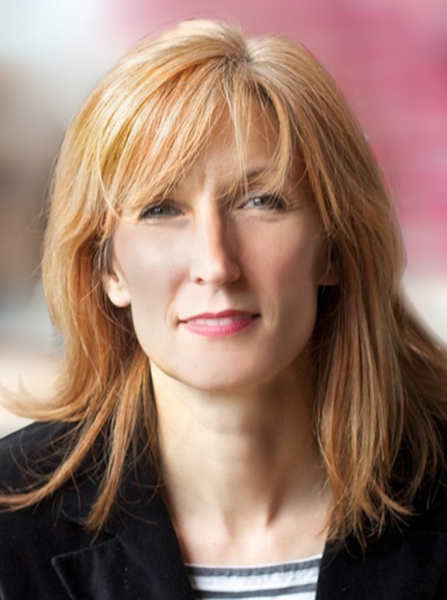
Bonnie Levine: How did you get started as a jeweler, and when did you realize you were hooked?
Rebecca Myers: I had to fulfill a craft requirement when I was a sophomore at Tyler School of Art in Philadelphia. While I was actually making something, the other kids in my class were melting things and setting their clothing on fire. I realized that I was actually pretty good at it. It initially was the path of least resistance. I then got hooked on figuring out how to design things that were desirable and wearable. Once I started down the path of putting an actual line together, the process got really exciting for me. I sold the small line I made my senior year to a gallery in New Hope, Pennsylvania. That $500 may as well have been $5,000. I was elated!
The hardest thing about building a successful jewelry line wasn’t acquiring or applying the skills, but figuring out how to make something that got people excited enough that they wanted to buy it, while still fulfilling my own aesthetic requirements. I wasn’t drawn to commercial jewelry, but was partially trained in that world. I worked for a jeweler in Milwaukee for five years or so. The skills I acquired working in that world have been a key to making the kind of work that appeals to the public. My work is the result of those skills, accompanied with an interest in fine art, fashion, and an art school education.
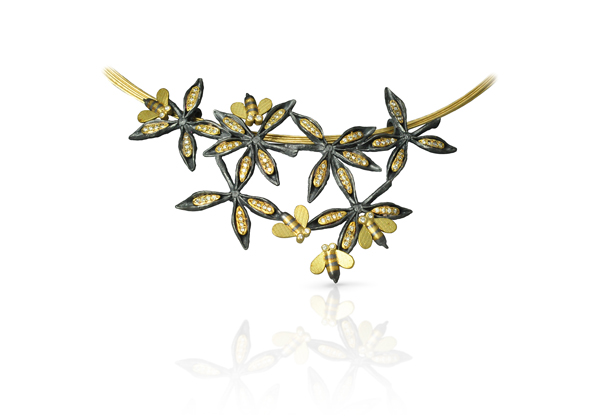
Rebecca Myers: I strive to make my work desirable because it makes the wearer feel sexier, more beautiful—not unlike a great piece of clothing or something tailored specifically for the client’s individual style to enhance her already existing beauty. We call it the “fairy dust” quality in the studio. When something is quiet but powerful, twinkles without being gauche, is sculptural/artful without being intimidating, textured but not enough to snag a beautiful garment—that’s when I decide to commit to a design. We experiment all the time in the studio. We design, cast, fabricate, and set everything in-house. Experimentation is key to keeping the work fresh. It’s not cost-effective to send things out to a casting house or a setter to experiment. I would say that is how the work stays current and grounded. I also am a firm believer in changing my work. If I’m getting bored, my clients must be getting bored. That’s when I start adopting new techniques and start looking at changing styles and materials in the studio.
Nature seems to figure heavily in your work, with bees and butterflies playing an important role. Where does your inspiration come from? Do you spend a lot of time outdoors?
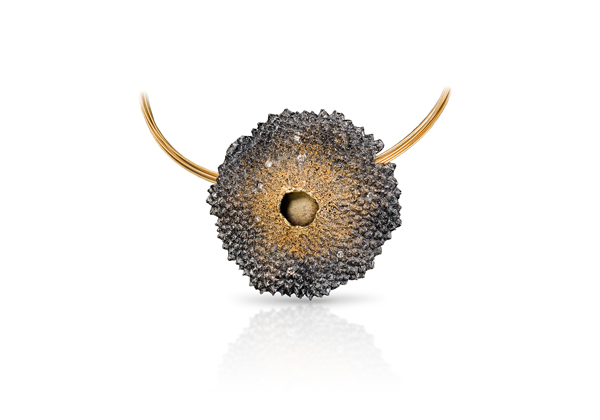
Your work has stayed true to using primarily metal and gemstones. Have you experimented with alternative materials or production techniques?
Rebecca Myers: I’ve limited my experimentation to certain materials, mostly for practical purposes. We did experiment with 3D printing and it was an unsuccessful first attempt. I did some experiments with ebony, carving it to use in lieu of stones or metal. I loved the contrast of the black wood with the lusciousness of pearls, high-karat gold, and gems. But it was very time-consuming and had to be put aside. I’m hoping to continue to work with it, maybe incorporating CAD technology with milling the wood. However, I don’t believe in developing work for the sake of using a technique. The work needs to dictate the most effective and efficient way it should be made.
You’ve said that in your world, fashion and art are bedfellows. Can you say more about that?
Rebecca Myers: Historically this is the case. Documentaries about the day-to-day workings of big fashion houses reveal our similarities. I completely identify with the frenzy at Chanel getting ready for their spring show. Jewelry is an art form, but also an accessory.
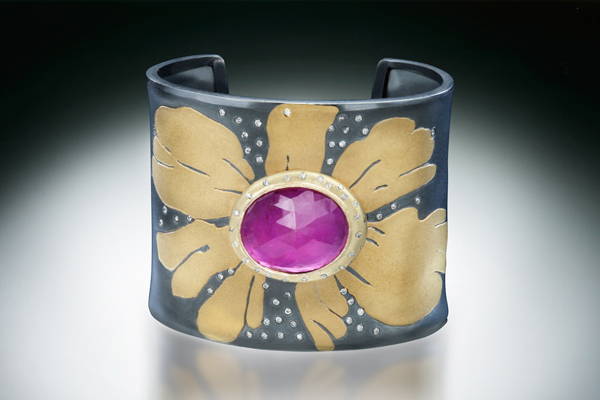
Rebecca Myers: The objective is always to make something beautiful and desirable. However, I have three different collections. One is very labor intensive, with monarch patterns and overlay. One is rougher, using cast forms from nature, and one is higher end, with lots of sparkle. Usually I design to the collection the piece will be identified with.
Tell us about your show at Gravers Lane Gallery. What work will you be presenting?
Rebecca Myers: Gravers Lane is run by my friend Bruce Hoffman. He’s been a big part of the Philadelphia craft world. We met at SOFA years ago when he was with Snyderman Gallery. I’ll be showing half of my full collection with him in December.
Have you seen a change in what customers want and how they buy jewelry?
Rebecca Myers: Not really. I think my own willingness to experiment and change my work has been well received. I have been doing shows nationally as well as working with wholesale clients for 20 years. I have a website that may drive someone to a show to see my work or vice versa, but I never really sell blindly off the site. People want to see the work and try it on. It seems it needs to be experienced with all the senses in order for someone to commit to it.
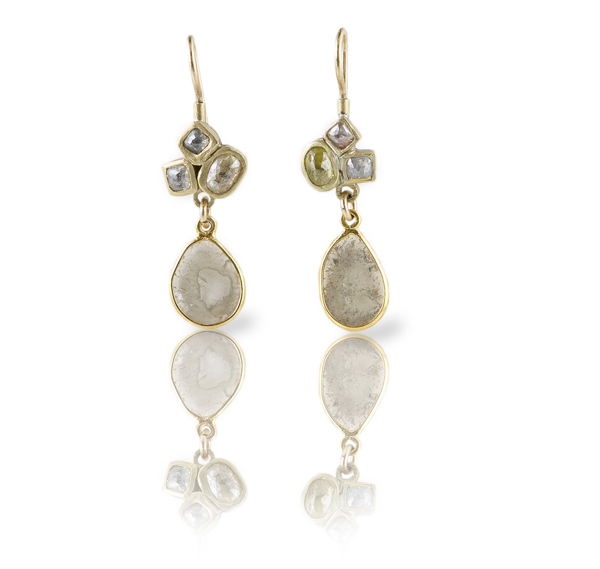
Rebecca Myers: Tenacity—the art world is not for the faint of heart. Don’t burn bridges. Handle disruptions effectively and gracefully. Be nice to EVERYONE—this is a very small world. Find humor in the absurd. Getting angry usually just puts bricks on your own shoulders.
What have you seen, read, or heard lately that made an impression on you?
Rebecca Myers: That could be a ridiculously long list. I’ll be brief…
I loved the Art of Scent exhibition at the Museum of Arts and Design (MAD) in 2012. It was so different; the way the room was laid out to present the scents was so clever, serene, and beautiful. It was an amazing experience.
The Daniel Brush show, also at MAD in 2012, called Blue Steel Gold Light. I have loved his work for many years, and the retrospective at MAD was a knockout. His work is unparalleled!
The Happy Show by Stefan Sagmeister, at the Institute of Contemporary Art at U Penn in Philadelphia in 2012. It was a study on happiness accompanied by amazing pieces by the artist. It was so clever and thoughtful.
Matthew Barney at the Guggenheim back in 2003. The Cremaster Cycle is still the most amazing art experience I have ever had. It is legendary for a reason.
My garden this past summer—it was spectacular.
The article about Hans Ulrich Obrist in the December 8, 2014, issue of The New Yorker—he is a genius curator. I was riveted by his story.
Thank you.
